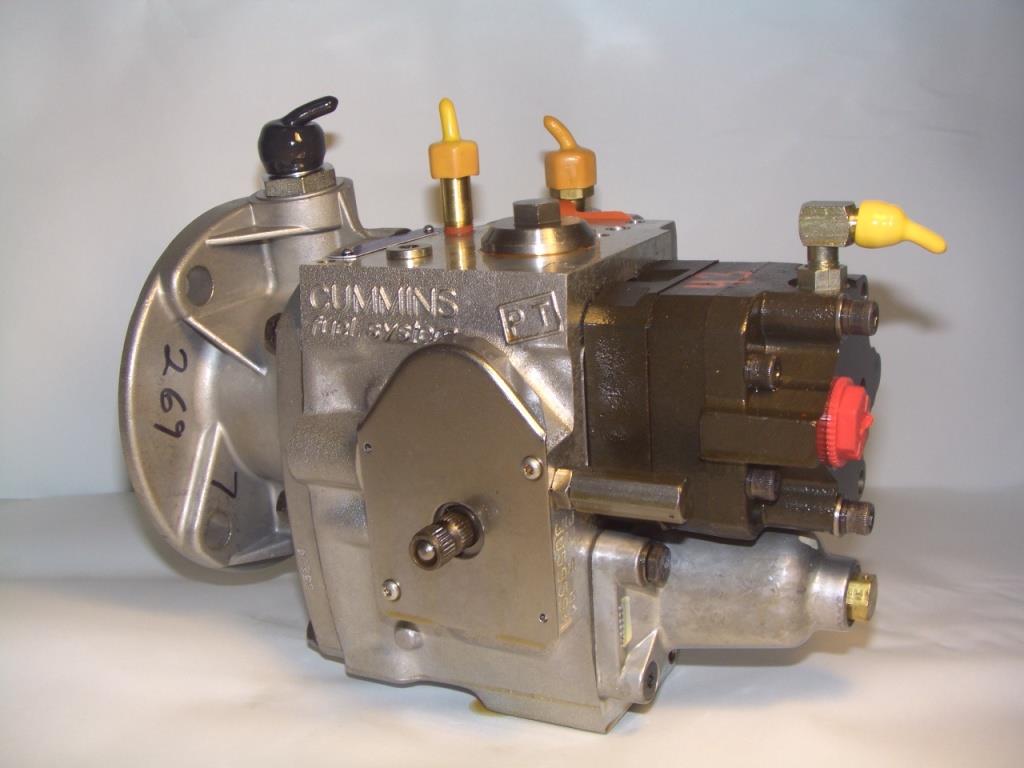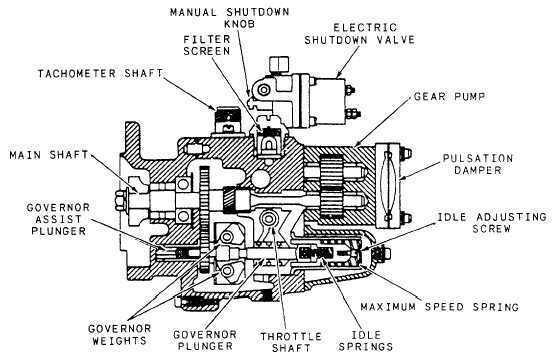Cummins 350 Big Cam Fuel Pump: Top Performance Upgrade
The Cummins 350 Big Cam fuel pump is a critical component of the Cummins Big Cam engines. It plays a crucial role in delivering the right amount of fuel to the engine for optimal performance. Whether you are looking to understand its functionality, find replacement options, or troubleshoot common issues, this comprehensive guide will provide you with all the necessary information.
Understanding Fuel Pump Function in the Cummins 350 Big Cam
The fuel pump in your Cummins 350 big cam is the unsung hero of the engine’s performance. Unlike gasoline engines that utilize a carburetor to mix fuel and air, diesel engines rely on a high-pressure fuel injection system for precise fuel delivery. This is where the fuel pump steps up to the plate.
Understanding the Cummins PT Fuel Pump System
The PT (Pressure-Time) fuel pump system is designed to generate and deliver a specified fuel flow rate at a predetermined pressure setting to the rail and injectors. Unlike traditional fuel pumps, the PT pump does not require timing to the engine, making it relatively easier to operate and maintain.
How does a fuel pump work in a diesel engine?
Let’s break down the science behind this essential component:
- Fuel Delivery: The fuel pump draws diesel from the fuel tank and pressurizes it. This pressurized fuel is then delivered to the fuel injection system.
- High-Pressure Fuel Pump (HPFP): In modern diesel engines, a high-pressure fuel pump (HPFP) is typically used. This pump generates the immense pressure required to inject fuel directly into the engine cylinders at the precise moment for optimal combustion.
- Precise Control: The engine computer (ECM) controls the HPFP, regulating the fuel pressure and injection timing based on engine needs. This ensures efficient fuel delivery and optimizes engine performance.
Big Cam vs. Small Cam: How They Affect Fuel Delivery
While both big and small cam Cummins 350 engines rely on a fuel pump for operation, the big cam’s increased air intake can influence fuel delivery requirements. We’ll explore this further in the next section.
Choosing the Right Fuel Pump for Your Cummins 350 Big Cam
When it comes to selecting the perfect fuel pump for your Cummins 350 big cam, there are several factors to consider:
Big Cam vs. Small Cam Fuel Delivery Needs:
- Stock Performance: If your Cummins 350 big cam maintains stock performance levels, the original equipment manufacturer (OEM) replacement fuel pump might be sufficient. It ensures compatibility and reliable operation.
- Performance Upgrades: If your big cam is part of a larger performance enhancement package, you might require an aftermarket performance fuel pump. These pumps are designed for higher flow rates and increased pressure to support the engine’s modified air intake and power output.
OEM vs. Aftermarket Fuel Pumps:
- OEM Replacement: Opting for an OEM replacement pump guarantees compatibility and a hassle-free installation process. It might be the preferred choice for those prioritizing reliability and maintaining a stock setup.
- Aftermarket Performance Pumps: Aftermarket options offer a wider range of performance capabilities. These pumps can deliver the increased fuel flow necessary for performance upgrades, but thorough research is crucial to ensure compatibility with your specific engine modifications.
Additional Considerations:
- Fuel Quality: Always use high-quality diesel fuel to maintain optimal fuel pump performance and lifespan. Contaminants in low-grade fuel can damage the pump.
- Fuel Filter Maintenance: Regularly replace the fuel filter to prevent contaminants from reaching the fuel pump and hindering its function.
Choosing the Right Fit:
When selecting a fuel pump, ensure it’s specifically designed for your Cummins 350 big cam engine model and year. Aftermarket parts suppliers often have search filters to help you narrow down compatible options. Consulting a trusted mechanic can also be beneficial, especially if you’re unsure about which pump best suits your needs.
In the next section, we’ll discuss the telltale signs that your Cummins 350 big cam’s fuel pump might be failing.
Signs of a Failing Fuel Pump in Your Cummins 350 Big Cam
A failing fuel pump in your Cummins 350 big cam can significantly impact performance and drivability. Here are some warning signs to watch out for:
- Loss of Power: This is a classic symptom. A failing fuel pump might not deliver enough fuel at the required pressure, leading to a noticeable decrease in engine power and acceleration.
- Engine Stalling: If the fuel pump struggles to maintain proper fuel pressure, your engine might sputter and stall, especially during idle or acceleration.
- Rough Idling: A fluctuating fuel supply can cause the engine to idle erratically, resulting in a shaky or uneven idle.
- Hard Starts: Difficulty starting the engine, especially when warm, can be indicative of a failing fuel pump that’s unable to build sufficient pressure for ignition.
- Check Engine Light: While not a guarantee of a bad fuel pump, the illumination of the check engine light often signifies an engine management issue. Retrieving the trouble codes with a scan tool can provide more specific details.
Important Note: These symptoms can also point to other engine issues. Consulting a qualified mechanic for proper diagnosis is recommended before replacing the fuel pump.
Replacing a Fuel Pump in Your Cummins 350 Big Cam (DIY with Caution!)
Replacing a fuel pump can be a complex task, and attempting a DIY repair on a critical component like the fuel pump requires a certain level of mechanical expertise and caution.
If you’re a seasoned mechanic comfortable working on fuel systems, a DIY fuel pump replacement might be feasible. However, for those less familiar with the process, seeking professional help from a qualified mechanic is the safer and often recommended approach.
In the next section, we’ll weigh the pros and cons of professional installation versus DIY replacement.
Professional Installation vs. DIY:
Swapping out a fuel pump on your Cummins 350 big cam can be a daunting task. This section will explore the advantages and disadvantages of both DIY and professional installation to help you make an informed decision.
Professional Installation: Pros and Cons
Pros:
- Expertise: Qualified mechanics possess the knowledge and experience to handle fuel system repairs efficiently and safely.
- Proper Tools: Mechanics have access to specialized tools that might not be readily available to DIYers.
- Warranty and Support: Many repair shops offer warranties on their labor, providing peace of mind in case of any issues after the installation.
- Faster Completion: Experienced mechanics can typically replace a fuel pump more quickly than someone tackling it for the first time.
Cons:
- Cost: Professional installation comes at a cost, which can vary depending on your location and the shop’s labor rates.
- Scheduling: Finding a shop with available appointments might require some scheduling flexibility.
DIY Installation: Pros and Cons
Pros:
- Cost-Effective: The biggest advantage of DIY replacement is the potential cost savings on labor charges.
- Sense of Accomplishment: Successfully completing the repair yourself can be a rewarding experience.
Cons:
- Skill and Knowledge Required: Replacing a fuel pump requires a good understanding of automotive systems, particularly the fuel system. Improper installation can lead to leaks, engine damage, and even fire hazards.
- Safety Concerns: Working with the fuel system involves inherent risks. Fuel can be flammable and hazardous if not handled properly. Ensure you have the necessary safety gear and knowledge to mitigate these risks.
- Time Commitment: Depending on your experience level, the fuel pump replacement can take several hours. Factor in the time required for research, gathering tools, and the actual installation process.
- Potential for Mistakes: Even a seemingly small error during installation can lead to leaks or improper functionality. Fixing these mistakes might require additional time, money, and potentially professional help.
The Right Choice for You:
The decision ultimately boils down to your comfort level, mechanical expertise, and budget. Here’s a quick guide:
- Choose Professional Installation if: You prioritize safety, lack the necessary experience or tools, or simply prefer to have a qualified mechanic handle the job.
- Consider DIY if: You’re a seasoned mechanic comfortable working on fuel systems, have the necessary tools and safety gear, and are looking to save on labor costs. Remember, prioritize safety and consult a professional if you have any doubts about your ability to complete the replacement correctly.
Remember: Safety is paramount when dealing with your fuel system. If you’re unsure about any aspect of the DIY fuel pump replacement process, don’t hesitate to seek professional help from a qualified mechanic.

Common Issues and Solutions
It’s not uncommon for high-pressure fuel pumps, including the Cummins 350 Big Cam fuel pump, to encounter faults. Some common issues may include leaks in the fuel line, air suction due to seal damage, or problems with the throttle shaft. It’s important to regularly inspect and maintain the pump to prevent these issues.

Credit: dieselcare.store
Replacement Options
If you are in need of a replacement Cummins 350 Big Cam fuel pump, there are several options available from various suppliers. Prices may vary, and it’s essential to consider factors such as warranty, refurbishment quality, and shipping times when making a purchase. Here are some reputable suppliers where you can find replacement fuel pumps:
| Supplier | Price Range |
|---|---|
| Diesel Fuel Pumps | Uline | $241.98 – $1,689.00 |
| Diesel Care and Performance | $395.00 – $520.00 |
| Dieselogic | $279.89 |
| Heavy Duty Pros | Amazon | $218.99 – $1,749.95 |
These suppliers offer a range of options to suit different budgets and requirements, ensuring that you can find the right replacement fuel pump for your Cummins 350 Big Cam engine.
Priming and Maintenance
Proper priming and regular maintenance are essential to ensure the optimal performance and longevity of the Cummins 350 Big Cam fuel pump. Be sure to follow the manufacturer’s guidelines for priming the pump and conduct routine inspections to detect and address any potential issues early on.
Frequently Asked Questions
How Much Hp Does A 350 Big Cam Cummins Have?
The 350 Big Cam Cummins has a horsepower range of 180-450 hp, depending on the specific model and application.
How Much Horsepower Does A 855 Big Cam Cummins Have?
The 855 Big Cam Cummins engine typically produces between 400 to 525 horsepower.
Do You Have To Time A Cummins Pt Pump?
No, you do not have to time a Cummins PT pump as it is designed to deliver fuel flow at a set pressure without timing adjustment.
Why Does A High Pressure Fuel Pump Go Bad?
A high pressure fuel pump can go bad due to wear from constant use, contaminated fuel, or lack of maintenance.
Conclusion
The Cummins 350 Big Cam fuel pump is a vital component that directly impacts the performance of your engine. By understanding its functionality, knowing where to find replacements, and staying on top of maintenance, you can ensure that your engine continues to run smoothly and efficiently.
Whether you are a truck owner, mechanic, or someone with a keen interest in diesel engines, the information provided in this guide will help you navigate the world of Cummins 350 Big Cam fuel pumps with confidence.



